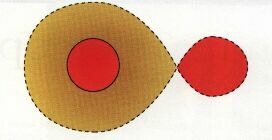Algols, Reverse Algols, Super Giants
UNL's Kam-Ching Leung confounds fellow astronomers repeatedly with new observations and theories.
written by Bob Sheldon
KamChing Leung is a self-styled maverick, an outlaw on the frontier of astronomy who is not afraid to go where no man has gone before.
Leung has made several unsettling discoveries in his career. In the 1970s he and colleagues found the first of some 20 or 30 pairs of binary stars
most of them discovered by Leung and colleagues in Lincoln--that didn't behave the way binary stars were supposed to. Binary stars differ from single stars in that they move about one another in an eternal slow dance; coming closer, moving apart, and moving close again. As seen from Earth, they eclipse one another in periods ranging from days to seconds.
Leung, who has studied binary star systems since the early 1970s, is cur rently focusing on close binary stars; stars so near to each other that their surfaces join together or almost touch. These stars are so close that some of their masses actually move back and forth from one to the other, so that in time, the star with the most mass be comes the least massive, and the least massive becomes the most massive.
"The first contact stars discovered revolved about each other in very short periods of time, a quarter of a day or so, Leung said. "Astronomers believed that all contact stars were pairs in which one star's mass was about the same as our own sun's mass, with the other star containing about half as much mass.
"In the early 1970s, we observed contact systems, now called massive or early-type contact systems, with much longer periods of revolution--and these systems contained stars up to 40 times or more the mass of our sun," Leung said.
Leung's observations were later accepted, but Leung continued to challenge accepted dogma. He was the first to describe a close contact system he calls a reverse Algol that behaves the opposite of the way paired stars of this type are supposed to behave. Most recently, he proclaimed the presence in the universe of what he calls supergiant contact stars--stars that despite their initial large distances from each other have become so huge in the course of their evolution that they interact and eventually come in contact as they revolve around each other like close pairs of binary stars.
Interesting. But what does it mean to us? Our planet revolves around a sun whose destiny is closely entwined with no other. Why spend time studying exceptions to the rules of star behavior?
Well, for one thing, they aren't exceptions. There are more double or multiple star systems than single stars, says Leung. It's possible that 70 to 80 percent of the stars in the universe belong to binary systems. And if binary stars are that abundant, Leung believes as a scientist that he should concentrate on what he considers the "most crucial stage" of binary star evolution.
"If we don't know what's happening at the contact or close-contact stage, we will never be able to comprehend the end phase of evolution in double stars," Leung said.
Studying the contact and near-contact stages of binary stars is difficult. Neither observations or computers are able to make complete sense out of what is happening in systems in which energy and mass constantly change and intermingle in ways that are even more difficult to quantify and analyze than the flow of air currents and water here on Earth.
One difference between single and double stars has to do with the masses of the two kinds of stars. In single stars, Leung said there is always a direct relationship between mass and size. "When stars are created, more massive stars are larger than stars with smaller masses," Leung said. "As they age, mass remains about the same but they grow in size, so that more massive stars are still larger.
But when astronomers looked at binary systems, they found that the smaller star was often more massive than the larger one. That's because of a process called mass exchange, in which the more massive star, as it expands in close proximity to the smaller star, transfers mass to its companion. Once astronomers accepted the phenomenon, and labeled all pairs of stars in which the smaller star had the most mass as Algol systems (named after one of the earliest double star systems discovered), they were shocked when Leung came along with his reverse Algols.
Most astronomers believed that the mass transfer phase didn't last very long, and once it was over, the system became stable. The difference between a regular Algol and a reverse Algol shows up as a difference in what astronomers refer to as the critical potential surface of stars in a binary system, according to Leung. In a regular system, the mass exchange process occurs because the more massive star's mass overflows its critical potential surface, while the star that was less massive at the start accumulates mass until it becomes the more massive of the pair. At this point, the other star, now containing less mass than the other, just fills its critical potential surface, or to put it another way, its surface is the same as its critical potential surface (see diagrams below).
Algol Systems When two stars in a binary system have undergone mass exchange, they should settle down permanently into the  sideways 'figure eight" configuration above -- the formerly more massive component (now less massive) just fills its critical potential surface at right of diagram. The other star (left), having acquired mass from the other star, is the more massive of the two and lies within its critical potential surface (shown by dotted line). Generally, astronomers believed that when a binary system reached this stage, it remained stable. These systems are called Algol systems after the first stars with this configuration that were discovered.
sideways 'figure eight" configuration above -- the formerly more massive component (now less massive) just fills its critical potential surface at right of diagram. The other star (left), having acquired mass from the other star, is the more massive of the two and lies within its critical potential surface (shown by dotted line). Generally, astronomers believed that when a binary system reached this stage, it remained stable. These systems are called Algol systems after the first stars with this configuration that were discovered.
Reverse Algols Systems Leung found several stars which violated the stable configuration described above. In these systems, the more  massive star (at left) just fills its critical potential surface, while the stellar surface of the less massive star at right lies inside its critical potential surface. This configuration, the opposite of that in an Algol system, is called a Reverse Algol.
massive star (at left) just fills its critical potential surface, while the stellar surface of the less massive star at right lies inside its critical potential surface. This configuration, the opposite of that in an Algol system, is called a Reverse Algol.
When Leung found binary systems in which the configuration was reversed --the more massive star's stellar surface was the same as the critical potential surface--many of his colleagues were astonished, for if they were correct in their original interpretation of regular Algols, then reverse Algols shouldn't exist. To date, only six to eight of these reverse Algols have been discovered.
"Nobody wanted to believe that there were reverse Algols,'' Leung said. "The time scale is supposed to be too short to catch them.
"It's as if we had caught these stars in a very early stage of evolution, which in terms of their entire life span wouldn't be a very long time," Leung said.
Leung thinks astronomers could be wrong about that--Ěthe "infant" stage of stellar evolution might last longer than they assume, or it might be that mass reversal oscillates back and forth between the reverse Algol acid contact phase for some time before it settles down into a regular Algol system."
Most recently, Leung has discovered that a lot of what were previously believed to be single stars, including some of the largest known stars in the universe, aren't single stars at all. They are components of double star systems in which distances are so vast, their contact relationships so difficult to ascertain, and their periods so long (100 to 150 days or more), that it isn't easy to locate their binary companions without concerted and selective effort. Working with observers at an observatory in Korea, Leung has located several such binary star systems, what he calls supergiant contact stars.
"The fact that there are only a few that have been seen doesn't mean there aren't a lot of them out there," he said. "The periods of the binaries involved are so long that it's hard to detect the binary relationships for such systems. Most people avoid these systems since they view them as 'less productive' for observational studies.
"If more astronomers start looking for them, we might discover a lot more out there." -- RES
Back to the Behlen Observatory Home Page
 sideways 'figure eight" configuration above -- the formerly more massive component (now less massive) just fills its critical potential surface at right of diagram. The other star (left), having acquired mass from the other star, is the more massive of the two and lies within its critical potential surface (shown by dotted line). Generally, astronomers believed that when a binary system reached this stage, it remained stable. These systems are called Algol systems after the first stars with this configuration that were discovered.
sideways 'figure eight" configuration above -- the formerly more massive component (now less massive) just fills its critical potential surface at right of diagram. The other star (left), having acquired mass from the other star, is the more massive of the two and lies within its critical potential surface (shown by dotted line). Generally, astronomers believed that when a binary system reached this stage, it remained stable. These systems are called Algol systems after the first stars with this configuration that were discovered.
 massive star (at left) just fills its critical potential surface, while the stellar surface of the less massive star at right lies inside its critical potential surface. This configuration, the opposite of that in an Algol system, is called a Reverse Algol.
massive star (at left) just fills its critical potential surface, while the stellar surface of the less massive star at right lies inside its critical potential surface. This configuration, the opposite of that in an Algol system, is called a Reverse Algol.